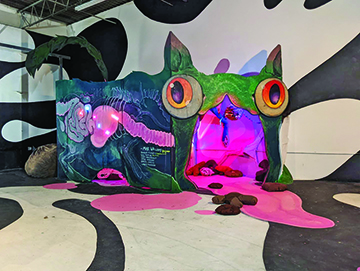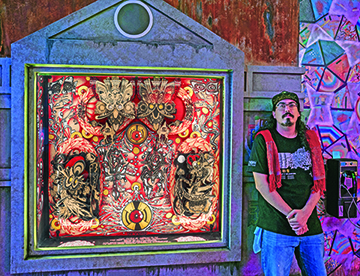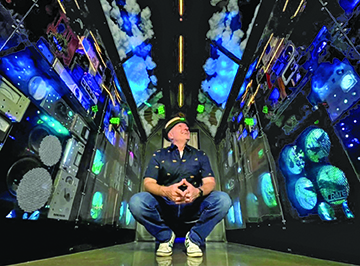Ground Floor Opinions About Denver’s Meow Wolf Installation
by Luke Schmaltz

Meow Wolf takes visitors through a journey of convergence through the multiverse — a confluence of four separate worlds which collide around the viewer’s senses.
Meow Wolf Convergence Station sits at the crossroad of Colfax Ave. and I-25 like a fortress of the extraordinary — a labyrinth of mind-bending worlds meant to immerse, inspire, and entertain.
The exhibits and attractions therein await to bombard visitors with an unmapped, unpredictable miasma of madness without warnings, wherewithal, or significant signage. The experience lands somewhere between interactive art museum and over-hyped tourist trap. Similar to the institution’s original location in Santa Fe, NM, and the subsequent installment in Las Vegas, NV, this destination is dripping with the artistic input of hundreds of contributors and collaborators — many of which are residents of the Mile-High City. The organization’s official statement is that among the 300+ artists who collaborated, exactly 110 were from Denver.
Whether Denver’s Meow Wolf installation is truly a monument to modern and postmodern art or a sensory overload amusement park on audio and visual steroids is a matter of opinion. These can range from positive to critical to indifferent — depending on one’s perspective and their position on the merits of big business converging with independent artists.
The Repurposing Diorama Maker
Scott Hildebrandt — aka Mr. Christmas — is a Denver-based artist who combines his love for miniatures and holidays into a unique brand of playful creativity. Hildebrandt applied to collaborate with Meow Wolf in 2017 and waited for two years before definitive plans to get to work were made. “In the summer of 2019,” he begins, “I began submitting plans, diagrams, specs, and requirements of the space that I would need. Then, over the rest of 2019, there were several meetings with lighting and sound teams to define my needs for this project,” he explains. “There was quite a bit of momentum at the beginning of 2020, until the pandemic halted everything. [By] late summer of 2020, I was able to finally get started by collecting materials mocking up my design. By fall, I was assembling and designing my concepts and building the framework. At the beginning of 2021, I was in full production mode with a hard fast deadline of May 1st to meet final inspections. For four months straight, I worked seven days a week, around 8 to 14 hours a day to make that deadline.”
Hildebrandt says he considers Meow Wolf to be a hub of artistic merit and an outstanding Denver treasure. “I truly believe that Convergence Station is an art installation and definitely an

Scott Hildebrandt specializes in miniatures and dioramas but his Meow Wolf collaboration is a macro-installation of his work.
art experience,” he says. “The whole venue encourages
playful curiosity and invokes imagination with art in a way that no other museum or gallery can. Denver is truly blessed to have something like this in their very own backyard. Not only is it good for Denver, but it is very good for the Denver art scene. Convergence Station showcases 110 Denver artists and shows how strong the Denver arts scene really is. Since I’ve started my journey as a full-time artist, I have had the opportunity to meet so many wonderful artists here in Denver. On any given First Friday, you can explore galleries all over Denver showcasing both new and old artists and be truly amazed at the talent that we have here,” he says.
The Insider
Mar Williams is a Denver illustrator who became involved with the Meow Wolf corporation in 2016 and was subsequently part of a 2019 class-action lawsuit against the company for discrimination. Williams is transgender, and alongside several other individuals had complaints against the company (a B Corporation) for unfair practices toward employees based on gender.
While the matter was resolved in early 2020, Williams maintains a distinctive opinion about Meow Wolf’s role in the arts community. “I’d like to include my earlier quote to Westword, which safely summarizes a lot of my perspective,” Williams says. “My hope is that they do more to lift individual artists than to absorb them.”
Williams goes on to explain, “To expand on a piece of that; Is Meow Wolf authentic art? I think it’s important to separate the brand from the art for that question. Maximalism and the ironic sincerity of meta modernism are ultimately hollow when coming from a brand, because the vulnerable human point of self-reference isn’t sincere or simply doesn’t belong to it. It’s like the Wendy’s (fast food chain) twitter account being edgy. It doesn’t mean anything. I think there’s plenty of authentic art and artists in that space, and while the bigger, flashier, more profitable container may drive more traffic to it, the container isn’t the art, and corporations aren’t collectives.”
The Multimedia Creative
While artist Dice 51 currently lives in Denver, he is originally from Albuquerque, NM. While he begins most of his work with pens on plain paper, that’s hardly where it stays. The end result of his continued attention to any particular piece can result in p

Mar Williams was one of the first Denver artists to become involved with the corporate megalith, and has distinct opinions on art that is purveyed by big brands.
ens, pendants, wood stacks, laser-cut wood-stained pieces, and more.
Dice’s native New Mexican heritage prompted him to apply to be a Meow Wolf collaborator. “I first started working with Meow Wolf through the events team. I would organize live art and vendors for certain shows at the Santa Fe exhibit, bringing in artist friends from around the country to display their work,” he explains. “I grew up in Albuquerque, so as a local artist in New Mexico I knew I wanted to contribute to Meow Wolf. Eventually with [some] help I was able to apply for the Denver exhibit,” he says. “I spent close to three months working directly on my piece for the exhibit, and the application process was about two years long. I did most of the design and building in the months before installation, then spent two weeks installing the piece.
Dice contends that the experience was unique but positive. “I’ve never worked on something so big,” he begins. “Luckily, I got full creative control once my proposal was accepted, so I could really dive into the creative process without any outside influences. There’s so many people that were involved that I still haven’t met. The result was amazing, I still stumble on work that I’ve never seen there whenever I get a chance to wander.”
Part of Meow Wolf’s brand is intertwined art installments without signage or explanation, leaving uncredited collaborators to take solace in the fact that they got paid to be a part of something big and beautiful. While every artist is credited on the Meow Wolf website, some were determined to put their personal stamp on their work so that curious visitors could find them if necessary. “I wish I was able to attach my name to my project more,” Dice says. “I had to get creative with it, so I hid it all throughout the piece and had a full write up displayed with my pieces in the giftshop. Some other artists fou

Dice 51 next to his Meow Wolf collaboration. The New Mexico native-turned Denver resident relishes his experience contributing to Meow Wolf Convergence Station.
nd great ways to get their name on their piece. I know one had a giant symbol made of QR codes in his room, and the QR codes lead to his website. I think something like that is the best move, something subtle enough it doesn’t take away from the art, but direct enough to actually connect to the millions of people who go to the exhibit. I definitely see Meow Wolf as an art installment. It’s like a giant art piece that you can walk inside of and be a part of. From the exhibit as a whole, to the tiny details hidden throughout, the entire experience is led by artists.”
The Outsiders
Speaking of galleries, one local artist who has curated a prominent presence among the First Friday visual art crowd goes by the moniker of W. Max Thomason. He holds the Meow Wolf phenomenon in ho-hum regard, saying, “Simply put, it is commercial art. No matter what title, label, and/or designation you give it, it is only commercial art. It is not fine art. Nor do I think it should ever be considered fine art. In all fairness though, having never spoken with the designers, creators, or decision makers I cannot say if it was ever meant to be considered fine art, but I do think it should not be viewed or judged as thus,” he contends. “If it inspires, motivates, or speaks to someone, fantastic. It has never done so to me. I think [the] assessment of a modern, repackaging of amusement park-style entertainment is a fair and accurate elucidation.”
Meanwhile, while most of the art world is in some way concerned with Meow Wolf, there are those who remain blissfully unaware of any such phenomenon. One such individual is Abe Brennan — a Denver musician and illustrator, enjoying a post-2020/2021 windfall of design work creating T-shirt art for bands. When approached about Meow Wolf, he blinked, shrugged and said, “Huh? Meow what? Never heard of it.”
Regardless, should you aspire to experience this immersive experience firsthand, be prepared to pay a hefty admission fee. Tickets are priced at $44 to $49, depending on age. Get your money’s worth by choosing an early arrival time and plan on being there for at least a few hours. Then, prepare yourself for a wild, nonstop hyper-stimulating, one-of-a-kind ride. Whether you’re an artist or a spectator, this destination has something for everyone.

